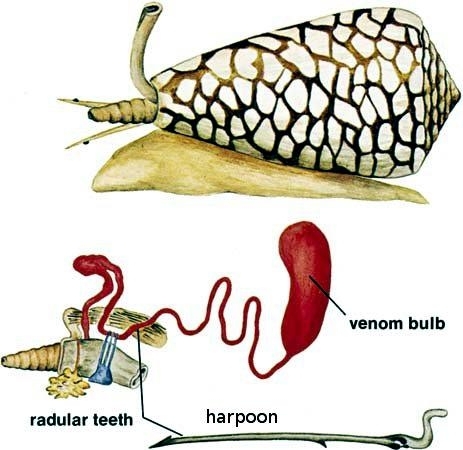

Behaviorįollow this link to additional information about cone snails. In a new study published in Science Advances. But the cone snails’ venom has more secrets yet to be revealed. At this time they are about 1.5 mm (0.06 in) in length. Scientists already know that the venom of cone snails, which prowl the ocean floor for a fish dinner, contains compounds that can be adapted as pharmaceuticals to treat chronic pain, diabetes and other human maladies. The larvae remain pelagic for about 16 days, then settle onto substrate. The few eggs that survive to hatch do so in about 16 to 17 days. The textile cone’s egg capsules contain 500-700 eggs each The capsules are laid under rocks. It is known to be cannibalistic if other food is scarce. This cone is a molluscivore, a mollusk eater. The average length of these animals is 9.0 cm (3.5 in). The background color is some variation of white or bluish white, with light to dark brown or yellowish overlapping textile markings, and three yellowish or brown interrupted spiral bands. The color and pattern of this beautiful cone is highly variable. There are slight spiral ridges near the base of the shell, and the rest is smooth.

The body whorl is convex with rounded or slightly angled shoulders. This marine cone snail has a highly glossy, heavy shell and a short spine with straight or slightly concave sides. The textile cone lives in the sand beneath coral and rocks in shallow waters.

Throughout the Indo-Pacific region, Australia, and the Indian Ocean from eastern Africa to Hawaii and French Polynesia. The spiral shells of the snail are the life-long habitat for the indwelling predator. The Conus genus, within the Conidae family, is a group of predatory gastropod mollusks. The venom from one cone snail has a hypothesized potential of killing up to 700 people. This species is not currently on exhibit at the Aquarium. The handful of humans that are stung by a cone snail is often subject to a venom potent enough to immediately paralyze and eventually kill its prey. “Our aim is to open new avenues for cancer and addiction research inspired on compounds from marine animals.CLIMATE CHANGE: Not Applicable At the Aquarium “We investigated in detail how RegIIA interacts with the alpha3beta4 nicotinic receptors and embarked on engineering new compounds that were more specific toward alpha3beta4 receptors and not other nicotinic receptors,” Dr. The team used alanine scanning mutagenesis to understand the selectivity profile of RegIIA at the α3β4 nAChR subtype, observing that two particular RegIIA analogs exhibited 3-fold more selectivity for the α3β4 than the α3β2 nAChR subtype. Within these conotoxins, the researchers found a compound, RegIIA, which has the capacity to block the alpha3beta4 (α3β4) nicotinic acetylcholine receptor (nAChR), which upon activation can influence lung cancer development and nicotine addiction.

In particular, venom from Conus regius, a species of cone snails, is especially rich in alpha conotoxins. One such class of these venom components is called alpha-conotoxins (responsible for targeting nicotin receptors that play a major role in lung cancer). The team found that the venom could selectively target cellular components and transform them into important drug leads and great tools to understand processes within the human body. “The venom is an extraordinary complex mixture of compounds with medicinal properties.” “The venom produced by these animals immobilizes prey, which can be worms, other snails and fish,” Dr. Marí and colleagues often catch these animals either by scuba diving or using deep-water submarines. Schmidt College of Science, was recently published in the Journal of Biological Chemistry.Ĭone snails can be obtained in the coast of Florida and can survive at different depths. The study, led by Frank Marí, Ph.D., professor in the Department of Chemistry and Biochemistry in FAU’s Charles E. The venom is incredibly complex, Mar says. Scientists at Florida Atlantic University have found that venom from cone snails, a type of marine mollusk, can help in the detection and treatment of some types of cancer, including lung cancer. Purple cone snail venom contains a large number of these protein building blocks, more than 2,000 of them.


 0 kommentar(er)
0 kommentar(er)
